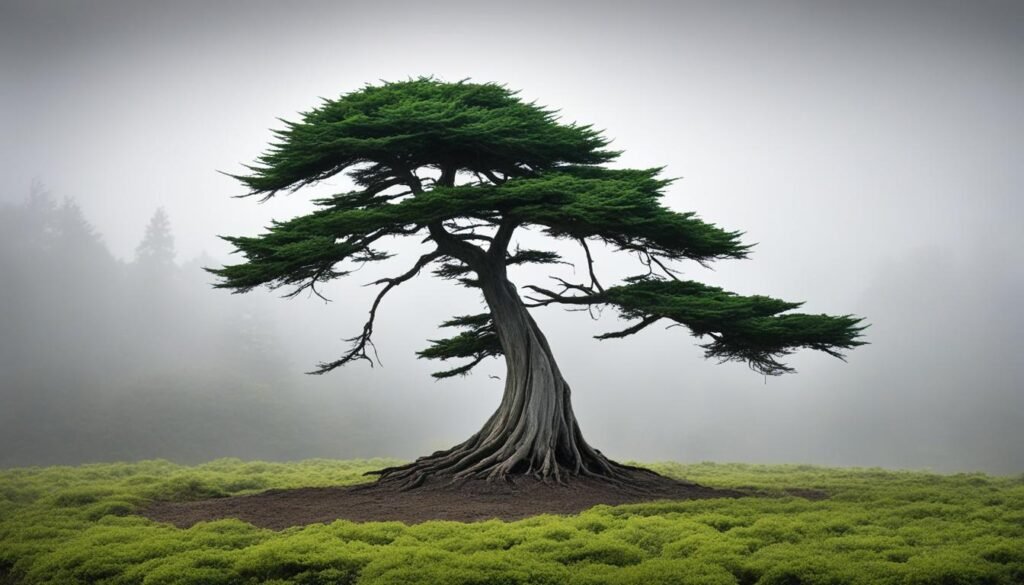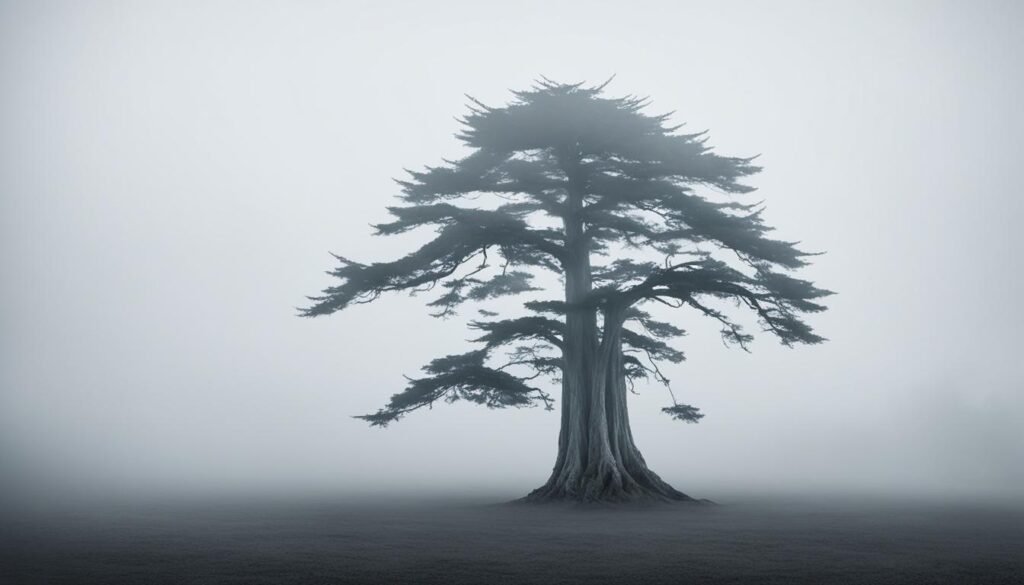Greetings! In this article, I will delve into the profound symbolism of the cypress tree in literature and art. The cypress tree has captivated the hearts and minds of creatives throughout history, serving as a powerful symbol of eternity, mourning, and immortality.
Key Takeaways:
- The cypress tree holds significant symbolic meaning in both literature and art.
- It is associated with concepts such as eternity, mourning, and immortality.
- The cypress tree’s symbolism can be traced back to ancient civilizations and mythologies.
- It is often depicted in literature and art to convey themes of grief, transcendence, and the fleeting nature of life.
- Cultural perceptions of the cypress tree vary across different regions and traditions.
The Historical Symbolism of the Cypress Tree
The cypress tree has a long and rich history of symbolism in various cultures across the world. Known as the “Graveyard Cypress,” it has been a classical mourning symbol used in Western and Eastern societies for centuries. This iconic tree holds deep significance and carries symbolic meaning that transcends time and cultural boundaries.
In Greek and Roman mythology, the cypress tree was considered sacred to the Fates and Furies, and it was closely associated with the rulers of the underworld. It symbolized the connection between life and death, serving as a warning against entering spaces corrupted by death. As a guardian of the afterlife, the cypress was often planted near graves as a protective barrier, guiding the souls to the realm beyond.
The Romans also embraced the symbolism of the cypress tree. They carried branches of the cypress as a sign of respect at funerals and processions. Additionally, the bodies of highly respected individuals were laid upon cypress branches before interment, symbolizing a final connection between the earthly realm and the heavens. This act reflected the belief that the cypress tree possessed a divine presence and served as a bridge between the mortal and the immortal.
The historical context of the cypress tree’s symbolism showcases its association with hope, eternity, and the transcendence of life and death. This symbolism has persisted throughout different cultures and time periods, highlighting the enduring power and universal significance of the cypress tree.
Cypress Symbolism in Literature
In literature, the cypress tree serves as a poignant symbol, evoking a range of emotions and imparting profound meaning. Often depicted in mourning depictions, paintings, and poetry, the cypress tree signifies themes of mourning, solitude, and transcendence. It is often portrayed in the background or as part of a larger scene, subtly weaving its symbolic power into the narrative.
The cypress tree’s association with death, grief, and remembrance imbues it with a sense of somber beauty. It stands as a visual representation of the eternal and the fleeting nature of life, capturing the essence of human existence in both its permanence and transience.

“Amidst the ancient cypress, I found solace in my sorrow, for within its graceful branches, I saw echoes of eternity.” – Anonymous
Cypress tree imagery in literature often conveys a sense of melancholy and contemplation. It symbolizes the universal experience of loss, inviting readers to reflect on the cyclical nature of life and the interconnectedness of past, present, and future. The cypress tree’s enduring presence in literary works resonates with readers, evoking empathy and offering solace in times of grief.
Famous Examples of Cypress Symbolism in Literature
Throughout literary history, many renowned authors have incorporated cypress tree imagery to enrich their narratives. For instance, in Dante Alighieri’s “The Divine Comedy,” the poet describes the cypress trees lining the entrance to the Inferno, highlighting their connection to the realm of the dead and the journey through hell. In Emily Dickinson’s poem “The Only Ghost I Ever Saw,” the cypress tree represents the enduring presence of lost loved ones.
The symbolism of the cypress tree in literature is multifaceted, encompassing themes of mortality, introspection, and the passing of time. From ancient Greek tragedies to modern masterpieces, the cypress tree continues to serve as a potent symbol that resonates deeply with readers, stimulating introspection and inviting contemplation of life’s transient beauty.
| Author | Work | Representation |
|---|---|---|
| Dante Alighieri | The Divine Comedy | Connection to the realm of the dead |
| Emily Dickinson | “The Only Ghost I Ever Saw” | Enduring presence of lost loved ones |
| William Shakespeare | Hamlet | Mourning and remembrance |
| Virginia Woolf | To the Lighthouse | Symbolic representation of the passage of time |
Cypress Symbolism in Art
The cypress tree has long been a beloved symbol in art, captivating artists for centuries, especially during the Neoclassical era. This iconic tree holds a deep sense of meaning and is prominently featured in various art forms such as paintings, sculptures, and more. The symbolism of the cypress tree in art encompasses themes of mourning, eternity, and spirituality, contributing to its enduring popularity.
Artists frequently depict the cypress tree in landscapes, gardens, or as a solitary figure, evoking a sense of melancholy and tranquility. Its tall and slender form, combined with its dark green foliage, creates a striking visual presence that resonates with viewers.
“The cypress at my mother’s abode is always green. The snows of winter cannot whiten it; the rising sun of summer cannot wither it; it remains forever fresh.”
The cypress tree’s symbolism in art is rooted in its association with mourning and remembrance. It serves as a poignant visual representation of the eternal and transient nature of life, as well as a connection to the divine. In many art pieces, the cypress tree provides a backdrop that enhances the emotional resonance of the artwork, conveying a sense of contemplation and introspection.

The Cypress Tree and Ancient Civilizations
From ancient Greece to Egypt, the cypress tree held great significance in the mythologies of various civilizations. Here is a closer look at some of the cultural connections:
In Greek mythology, the cypress tree was linked to Hades, the god of the underworld. It was said to be sacred to the Fates and Furies, acting as a symbol of the realm of the dead. The tree’s dark and somber appearance was seen as a reflection of the underworld’s mysterious and foreboding nature.
The ancient Egyptians associated the cypress tree with Osiris, the god of the afterlife. They believed that planting cypress trees near tombs would ensure the safe journey of the deceased to the realm of the gods and grant them eternal life.
In Roman mythology, the cypress tree was considered a symbol of protection, guarding the entrance to the underworld. Romans would often plant cypress trees near their homes and graves as a way to safeguard against evil spirits and bring good fortune.
The Symbolic Power of the Cypress Tree
The presence of the cypress tree in myths and legends underscores its symbolic significance. It represents the continuation of life beyond death, the eternal soul, and the interconnectedness of the spiritual and earthly realms. The cypress tree’s enduring symbolism continues to inspire awe and wonder, reminding us of the mysteries of existence and the cyclical nature of life.
| Mythology | Symbolic Associations |
|---|---|
| Greek | Realm of the dead, eternity |
| Egyptian | Afterlife, immortality |
| Roman | Protection, good fortune |
Characteristics of Cypress Trees
Cypress trees, belonging to the Cupressaceae family, are coniferous trees with distinct characteristics that make them unique. Let’s explore some of their key features:
Tall and Slender Shape
Cypress trees are known for their majestic appearance, characterized by their tall and slender shape. Their elongated trunks and upward-reaching branches give them a graceful and elegant presence.
Pyramid-like Branches
The branches of cypress trees form a distinctive pyramid-like structure, creating a visually appealing silhouette. This branching pattern enhances their overall aesthetic appeal, especially when seen against the backdrop of a clear sky.
Dark Green or Bluish-Green Leaves
The leaves of cypress trees can take on two main forms: scale-like or needle-like. These leaves are typically dark green or bluish-green in color, adding to the tree’s overall beauty.
Adaptability to Various Environments
Cypress trees are versatile and can adapt to a range of environments. They thrive in wetlands, swamps, and coastal areas, demonstrating their resilience in challenging conditions. This adaptability is a testament to their hardy nature.
Durable and Rot-Resistant Wood
The wood of cypress trees is highly valued for its durability and resistance to rot. It is often used in construction, furniture making, and outdoor applications. This characteristic makes cypress wood desirable and long-lasting.
Overall, cypress trees possess a unique combination of elegant appearance, adaptability, and durable wood, making them a cherished part of natural landscapes, gardens, and artistic representations.

Key Themes:
- The cypress tree as a cautionary symbol against unrestrained ambition
- The symbolic significance of the towering growth of cypress trees in biblical texts
- Highlighting human flaws and the potential downfall that may come from unchecked earthly ambitions
Notable Quotes:
“Beware the towering growth of ambition, for the cypress tree serves as a symbol of human flaws and the potential downfall that may come from unchecked earthly aspirations.” – Ecclesiastes 5:10
Cultural Perceptions of Cypress Trees
Cypress trees hold varied cultural perceptions and symbolisms in different parts of the world. In Western cultures, these majestic trees are often associated with notions of death, mourning, and remembrance. On the contrary, Eastern cultures view cypress trees as symbols of grace, joy, purity, and longevity. These contrasting cultural perspectives shape the way cypress trees are depicted and understood in literature, art, and folklore.
The Symbolism of Cypress Trees in Western Cultures
In Western cultures, cypress trees are deeply rooted in the symbolism of death and mourning. They are frequently found in cemeteries and graveyards, serving as solemn reminders of mortality and the passage of time. The enduring greenery of cypress trees represents eternal life and the memory of loved ones who have passed away. These cultural associations give cypress trees a melancholic yet reverential presence in Western art, literature, and funerary traditions.
The Symbolism of Cypress Trees in Eastern Cultures
In Eastern cultures, cypress trees are seen as symbols of beauty, purity, and longevity. These elegant trees embody grace and resilience, often depicted in serene landscapes and gardens. Cypress trees are particularly significant in Persian and Japanese art, where they symbolize endurance, vitality, and the cycle of life. Eastern cultures celebrate the beauty and spiritual significance of cypress trees, associating them with joy, immortality, and the pursuit of a harmonious existence.
The Influence of Cultural Perceptions on Cypress Tree Symbolism
The cultural perceptions of cypress trees offer valuable insights into how different societies interpret and appreciate nature’s symbolism. While Western cultures tend to focus on the melancholic aspects of life and mortality, Eastern cultures embrace the beauty, vitality, and spiritual qualities of these magnificent evergreens. These contrasting perspectives contribute to the diverse array of literary, artistic, and cultural representations of cypress trees worldwide.
| Western Cultures | Eastern Cultures |
|---|---|
| Death | Grace |
| Mourning | Joy |
| Remembrance | Purity |
| Eternity | Longevity |

Whether towering over ancient graveyards or gracing the pages of poetic verses, the cypress tree captivates our imagination and reminds us of the immortality woven into the fabric of existence.
Symbolism of the Cypress Tree
The symbolism of the cypress tree varies across cultures, but its essence remains constant. Here are a few key symbolic meanings associated with cypress trees:
“The cypress stands apart in its emerald shade, the symbol of our immortal hopes and faith, the cherished emblem of the rest to come. It represents the assurance that all life is eternal, that death is but the gateway to a larger future.” – Helen Keller
- Continuity: The evergreen foliage of the cypress tree signifies the unbroken continuity of life, even in the face of death and change.
- Endurance: The resilience of the cypress tree, standing strong in various environments, symbolizes the endurance of the human spirit and its ability to overcome challenges.
- Transcendence: The cypress tree represents the transcendence of worldly limitations and the connection between the mortal and the divine.
- Hope: Cypress trees offer a glimpse of hope in the face of sorrow and loss, reminding us that life continues beyond the boundaries of our physical existence.
Through its profound symbolism, the cypress tree invites us to contemplate the mysteries of life, mortality, and the eternal nature of the soul.
| Culture | Symbolic Meaning |
|---|---|
| Ancient Greece | Associated with the realm of the dead and the deities of the underworld |
| Christianity | A symbol of the soul’s journey towards salvation |
| Persian Culture | Represents grace, purity, and the eternal |
| East Asian Cultures | Symbolizes longevity, vitality, and resistance to decay |
Across time and space, the cypress tree continues to inspire and captivate, serving as a timeless symbol of the immortality that resides within each of us.
The Cypress Tree in Dreams
The symbolism of the cypress tree extends even into the realm of dreams. Dreaming of a cypress tree can evoke a range of emotions and themes, including sorrow, loss, personal growth, vitality, and caution against unchecked ambition. The interpretation of a cypress tree in a dream depends on the dreamer’s personal experiences, emotions, and the context of the dream itself.
When a cypress tree appears in a dream, it can often reflect a sense of melancholy or grief. The tree’s association with mourning and remembrance can manifest in feelings of sorrow or the need to process loss. However, it’s important to consider the specific details and emotions within the dream to gain a deeper understanding of its meaning.
On the other hand, dreaming of a cypress tree can also symbolize personal growth and vitality. The tree’s enduring nature and resilience may be an indication of the dreamer’s own strength and ability to overcome challenges. It can serve as a reminder to persevere and embrace the opportunities for growth and renewal.
Furthermore, a cypress tree in a dream can act as a cautionary symbol against unchecked ambition. It may signal the importance of considering the potential consequences of one’s actions and decisions. The towering presence of the cypress tree can serve as a reminder to find a balance between ambition and humility.
It’s worth noting that dreams are highly personal and subjective, and the interpretation of a cypress tree dream can vary from person to person. To gain a deeper understanding, it may be helpful to reflect on the emotions, imagery, and overall context of the dream. Consulting a dream dictionary or speaking with a professional dream interpreter can also provide additional insights.

The Universal Symbolism of the Cypress Tree
The symbolism of the cypress tree goes beyond specific cultures and time periods. It encompasses universal meanings of sorrow, eternity, resilience, and hope. The iconic imagery and rich symbolism of the cypress tree make it a powerful symbol in literature and art across the world, transcending cultural boundaries and resonating with people from different backgrounds.
“The cypress tree stands as a universal symbol of both mourning and the enduring power of the human spirit. Its tall and slender form represents the strength and resilience to withstand the trials of life, while its evergreen leaves remind us of the continuity of existence and the possibility of eternal life.”
Throughout history, poets, writers, and artists have been captivated by the symbolic potential of the cypress tree. Its presence in literature and art serves as a visual and emotional representation of the human experience, connecting us to the profound concepts of life, death, and the beyond.
- Sorrow: The cypress tree is often associated with sorrow and grief, reflecting the universal human experience of loss and mourning.
- Eternity: With its evergreen foliage and long lifespan, the cypress tree symbolizes the eternal cycle of life and the promise of immortality.
- Resilience: The tall and slender silhouette of the cypress tree represents strength and resilience, reminding us of our ability to endure and overcome challenges.
- Hope: Despite its association with mourning, the cypress tree also embodies hope, offering a glimpse of solace and the possibility of transcendence.
The universality of the cypress tree’s symbolism is evident in its presence in different cultures and artistic traditions. From ancient mythology to contemporary literature and art, the cypress tree continues to inspire and evoke profound emotions, leaving a lasting impact on those who encounter its powerful symbolism.
The Cypress Tree in Different Cultures:
| Culture | Symbolic Associations |
|---|---|
| Greek and Roman | Mourning, connection to the afterlife |
| Persian | Eternal life, purity, grace |
| Japanese | Longevity, resistance to decay |
Across different cultures, the cypress tree holds a special place, carrying diverse but interconnected meanings. Whether it’s the ancient Greeks and Romans associating it with mourning and the underworld or the Persian and Japanese cultures connecting it with purity and longevity, the cypress tree’s universal symbolism speaks to the timeless themes that touch the human soul.

Conclusion
The symbolism of cypress trees in literature and art is deeply rooted in human culture, resonating with themes of eternity, mourning, and immortality. Throughout history, this iconic tree has inspired countless works of literature and art, evoking powerful emotions and conveying profound symbolic meaning. Whether portrayed as a solitary tree, integrated into landscapes, or used as imagery for mourning and transcendence, the cypress tree continues to captivate audiences with its timeless resonance.
From its association with the afterlife in mythology to its portrayal in mourning depictions and poetry, the cypress tree holds a significant place in the literary world. Its presence often serves as a visual representation of the eternal and the transitory nature of life, reminding us of the impermanence of our existence.
In the realm of art, the cypress tree’s symbolism is equally prominent. Its portrayal in paintings, sculptures, and other art forms reflects themes of mourning, eternity, and spirituality. The cypress tree’s depiction in landscapes and gardens conveys a sense of melancholy and tranquility, adding depth and emotional resonance to artistic compositions.
The symbolic meaning of the cypress tree varies across cultures, yet it remains universally significant. It represents concepts such as sorrow, endurance, and the continuity of existence. Whether in Western or Eastern cultures, the cypress tree carries a powerful message of both mourning and hope, reminding us of the cyclical nature of life and the potential for transcendence.
FAQ
What is the symbolic meaning of the cypress tree in literature and art?
The cypress tree is often associated with concepts such as eternity, mourning, and immortality. It is frequently depicted in literature and art to convey these symbolic meanings.
What is the historical symbolism of the cypress tree?
The cypress tree holds significant symbolism in various cultures. It is associated with concepts such as mourning, remembrance, and the afterlife. The tree was often planted near graves as a warning against entering a place corrupted by death.
How is the cypress tree depicted in literature?
In literature, the cypress tree is often used as a powerful symbol to convey themes of mourning, solitude, and transcendence. It is frequently depicted in mourning depictions, paintings, and poetry, usually in the background or as part of a larger scene.
How is the cypress tree depicted in art?
The cypress tree is often depicted in paintings, sculptures, and other art forms to symbolize mourning, eternity, and spirituality. It is typically portrayed in landscapes, gardens, or as a solitary tree, conveying a sense of melancholy and tranquility.
What is the significance of the cypress tree in mythology?
The cypress tree is associated with the realm of the dead in various mythological traditions. It is often planted near cemeteries or used to construct burial monuments. The tree is believed to represent the eternal soul and the concept of life beyond death.
What are the characteristics of cypress trees?
Cypress trees are coniferous trees known for their tall, slender shape and pyramid-like branches. They have scale-like or needle-like leaves that are typically dark green or bluish-green in color. Cypress trees are adaptable to various environments, including wetlands, swamps, and coastal areas.
How is the cypress tree portrayed in Eastern art?
In Eastern art, particularly in Persian and Japanese art, the cypress tree is often depicted as a symbol of eternal life and resilience. It represents grace, purity, and resistance to decay, and is associated with religious ceremonies, temple architecture, and the concept of longevity.
What is the symbolic meaning of the cypress tree?
The cypress tree represents concepts such as sorrow, melancholy, eternal life, and the continuity of existence. It is associated with both mourning and hope, serving as a reminder of the impermanence of life and the possibility of transcendence. Its evergreen nature and resilience symbolize endurance and the enduring power of the natural world.
How is the cypress tree mentioned in biblical tradition?
In the Bible, the cypress tree is mentioned in various contexts. It is associated with caution against unrestrained ambition and unrealistic aspirations. The towering growth of the cypress tree serves as a symbol of human flaws and the potential downfall that may come from unchecked earthly ambitions.
How are cypress trees perceived in different cultures?
Cypress trees have different cultural perceptions and symbolisms across the world. In Western cultures, they are often associated with death, mourning, and remembrance. Eastern cultures view cypress trees as symbols of grace, joy, purity, and longevity. These cultural perceptions shape the way cypress trees are depicted and understood in literature, art, and folklore.
What is the role of cypress trees in funerary and mourning traditions?
Cypress trees have played a prominent role in funerary and mourning traditions throughout history. They are often planted in graveyards and used to line coffins, symbolizing a connection to the afterlife and eternity. Cypress branches are also used to create wreaths and adornments, serving as visual symbols of grief and sorrow.
What do cypress trees symbolize in relation to immortality?
Cypress trees are often associated with the concept of immortality and eternal life. Their evergreen leaves and resilient nature symbolize the continuity of existence and the endurance of the human spirit. They represent the enduring power of the natural world and the possibility of life beyond death.
What is the symbolism of the cypress tree in dreams?
Dreaming of a cypress tree can evoke feelings of sorrow, loss, personal growth, vitality, or caution against unchecked ambition. The interpretation of a cypress tree in a dream depends on the dreamer’s personal experiences, emotions, and the context of the dream itself.
What is the universal symbolism of the cypress tree?
The cypress tree carries universal meanings of sorrow, eternity, resilience, and hope. Its iconic imagery and rich symbolism make it a powerful symbol in literature and art across the world, resonating with people from different backgrounds and transcending cultural boundaries.




